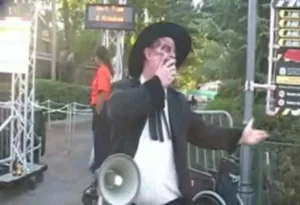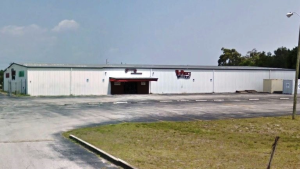Most scare acting and haunt direction mistakes can be summed up in what I believe in a simple statement. “No one wants a Taunted House.”
Maybe someone does, but if successful and enduring Haunted Attractions tell us anything, it is that ones who attempt to taunt instead of haunt don’t do as well.
I will not waste your time going into what are sometimes referred to as “extreme haunts.” Even they mostly seem to fade away. If you want to learn more about those you can research the term and find what they tend to be.
What I am focusing on is the day to day, or nightly operation of scare acting and its direction. This may be a shock to some, but your major haunted attractions at theme parks were not always sound trigger heavy in their design. They were either directed with strict phrases or trusted with some improvisation for the performer’s discretion. I am willing to put money on, even though we love Haunted Attractions, longtime fans could find something they thought the performer should not have said to them or to a fellow guest within earshot.
I have personally been a performance director for many local haunts, professional events and coordinator for others. So how can you have a character that gets hairs on arms or neck to stand up without getting under their skin in a way you don’t want?
One has to analyze the point of what is said. Is it in character? Was the comment to the guest a personal attribute comment? Or was it more of what the character would know about the character that enhances the scary motive of the character rather than the guest hearing the performer say something irrelevant and personal. It is not perfect, but I will give an example. In 2006, when Horror came Home to Universal Studios Florida, there was a house titled Dungeon of Terror: Retold, featuring The Storyteller Icon known as Elsa Strict. Parallel to the nylon-roped queue line, a ” Scareactor” was cast to be pacing with a megaphone, playing the part of a traveling puritan. After scouting his queue captive audience, he stops directly in front of my friend Sean to say “Hello dear friend. We are so excited for you to get to enter our world. We are going to reach into your heart my friend” As he said this, he gestures with the hand not holding the megaphone a reach to Sean’s chest as if he was going to grab his heart. “We are going to find your love and spread that love from your heart all over our walls. We will paint our walls with the love your heart provides’ ‘ as his physical performance let Sean, myself and everyone nearby know that this character wanted his blood, and it would be on the walls of this Dungeon of Terror exhibit with likely all of ours and those before us.

Puritan Preacher character in queue line of 2006’s Dungeon of Terror at Halloween Horror Nights 16. Photo Credit: halloweenhorrornights.fandom.com
Never once did the performer make Sean feel less. It was personal in intensity, but a character would not likely care about Sean’s name. He never asked. He did not point out anything about Sean other than his heart and or blood would be wanted and would be shed. After all this Dungeon of Terror was a haunted house, not a taunted house.
This is a similar kind of interaction one can still sometimes get from improvisational or approved lines from show direction at such major events in Scare Zones. Sound triggers are great as they save an actor’s voice and give consistency for guests. Sometimes, even sound triggers have to be careful in how they are scripted.
I hope many people remember Graveyard Games from Halloween Horror Nights 2019. It was one of my favorite times as a guest and working there as a coordinator. A coordinator has a task to really protect and serve the cast. Everyone in these events are passionate magicians. I tried my best and if you recall this house, you may remember the first scare came from the punk teen character vandalizing the graveyard. “Dork” with a laugh and spray paint sound was the audio triggered. For those in the social contract and aware of the story taking place, this is no big deal. Context clues probably also help a lot. But one time I found while assisting a cast change that a guest at the exit was trying to call out one of our performers for insulting them. When I was there to hear the details the phrase “dork” was what the guest for sure heard. I explained the situation and the guest calmed down. Things are always taken and reviewed seriously. No one wants to come across like a taunted house. Luckily, Graveyard games did this well and the guest realized because it was not a specific insult or taunt, that it was a pre-recording. I personally loved that scare so much, but I am always a sucker for a scare that does not come from the heavy or obvious from a storyline. The phrase Dork even if directed at someone is not personal, and although directed at guests passing by, we know this is what a stereotypical teenager vandalizing a cemetery would say if he was generically insulting someone, to say the least. The spray paint and action gave great context clues.
Now let me take your back to the time before sound triggers within the house. The visitation scene of Hellgate Prison was quite intense, and while I took it well, there were things and insults said by performers that I think great show direction and sound triggers have kept things away from and avoided potential issues since.
One time, and I must laugh and feel bad at the same time reading this, I worked at a haunted attraction in North Fort Myers called Nightmare. It was great in sets as they were purchased from a large haunt that closed in Georgia that our local Roller Rink owner wanted to plop together in his building. It came with most of the props and tech for its gags and illusions. It even had a few built- in sound triggers, but actors were left to scare how they chose. There was no direction. It was a montage of horror kind of design. In this house was a fellow playing a non-copyright ghost face character on a back porch with a varsity Jacket-wearing dummy tied up to a lawn chair in front of a swinging patio door that the performer could burst from. And bust he did.
I was in a catacomb zombie scene that immediately followed his scene. I feel like an awful person for chuckling with the memory as I type this because his bursts became more and more taunting. At one point I heard guests going through, and out this guy rushed towards them as a copyright infringement ghost face with his best attempt at a ghost face’s modulated voice “I’m going to gut you like a fish, I am going to slice you.” If it stopped there, it would have been on-brand enough. But it did not. My flesh-eater mouth agape from what I continued to hear: “I am going to murder your mom, your dad, your grandparents and your siblings.” Then turning the corner into my catacomb’s scene, through my boo-hole vantage point I see a mom with a girl who can’t be more than nine years old. It is funny now because of how egregious and specific his words were. Was he acting in character? Sure, if a ghost face had to threaten someone for twenty seconds straight. That does not happen. It’s a stretch to say it was appropriate. He also went far too personal. It becomes past the social contract of a scare and comes across like this guy just wants to really threaten you.
I wish this was the only funny story with this chap, if you ever want an even wilder funny story from this guy that I think to whenever I am down, find me and ask me about the time he played copyright infringement Jason at Camp Crystal Lake.

The Nightmare Haunted House of North Fort Myers had it all. Size, scale, cast, just not direction.
All of the troubles, including the concerning examples I have told and the funny Jason one I will tell you privately could have been avoided if the owner of this haunt would have simply cared about show direction. Nightmare Haunt only lasted that season. Big surprise, I know. People returned to skating by mid-November, and I hope no kids have had their families threatened to be killed there since.
So what is the way to avoid this whether you are designing a major haunt or garage haunt for Halloween? The good news is the principles are the same. Clear direction and expectations for your cast, but also just when you think of guests experiencing your haunt. Think of the role of the guest. You want personal touches and to bother their instincts, that’s how most fear works. Give the guest a clear role. You will notice some of the most memorable Haunts at theme park haunts do this as well. I am particularly excited about Halloween Horror Nights 32 as most zones and houses seem to be giving guests a clear role of what we are walking into or stumbling upon. It allows things not to be a summary of a movie and keeps it personal. People want a thrill ride that thrills them, and we all likely know a thrill ride that rattles us too much to be one.
Results of course may vary, but to me, this is the difference between a haunt attempting pop culture, and one more akin to Popp Culture.
